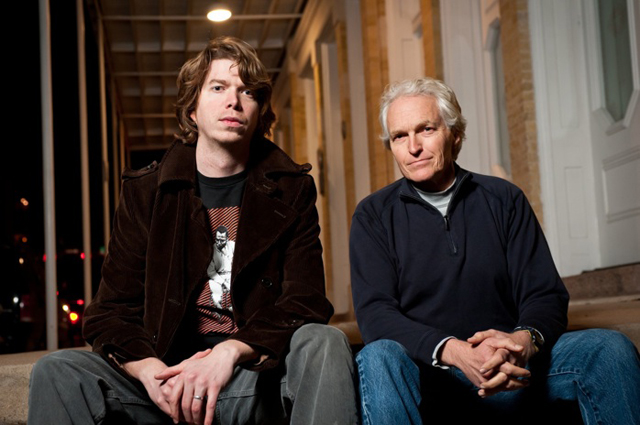UT Professor, Alum Premiere "Incendiary" Documentary At SXSW (Watch)

Not long ago, a UT professor and his student had a challenging conversation. They'd read a story about Cameron Todd Willingham, a Texas man executed in 2004 for setting a fire that killed his three daughters.
But scientific research — and doubt — had emerged on the case. Had Willingham actually committed the crime, professor Steve Mims and student Joe Bailey Jr. wondered?
Unlike the millions of professor-student conversations that provoke thought and float away, Mims and Bailey made a movie exploring the question.
Incendiary: The Willingham Case premiered at SXSW Film, winning the Louis Black/Lone Star Award. Here's what the filmmakers had to say about making it.
You read the wave-making New Yorker story on the Willingham case. Did you think movie right away, or when did that come?
Mims: I just thought it was a great story, really long, really well-written, and kind of shocking. Joe was in my film production class, and we had a conversation about it.
Bailey: Steve sent me a link to the David Grann story. I wrote him and said we should make a film out of it.
Mims: But it was an epic story — a story that’s been going on for 20 years now. Plus documentaries are hard — you have to collect so much information and at the end hope there’s a story there. There is tons of travel, and untold hours of editing. You can’t casually commit to that — but I sort of did.
Is Cameron Todd Willingham the protagonist, even though he was executed in 2004?
Bailey: I think if anyone emerges as the protagonist, it’s probably science.
Does the film focus more on science or more on the law?
Bailey: I think it’s heavier on the science. The only role of law in the film is asking how the two intersect, how they’re allowed to intersect. That’s something courts have been grappling with for a long time.
Mims: The mystery is what actually did happen rather than what the evidence shows. That’s why it’s grown into a controversial case even 20 years later. We have many voices in the film from both sides to help you think what might be true and why people are saying what they’re saying. We don’t have a narrator in the film — we want the people to speak for themselves.
You say it’s surprisingly funny. Is that blasphemy?
Mims: Absolutely not. There are many places where people are going to laugh out loud, and it’s organic. It’s full of macabre humor that unfolds out of the context of the film. It’s entertaining, but it’s not even depressing. It’s about a tragedy, but we in many ways tried to avoid the emotional characterization of the story. In the end it’s like a puzzle — it’s like a mystery. Even today as we sit here there is ambiguity in it. People may end the film, have one impression, sleep on it, and wake up with another impression.
Bailey: Just to explain the humor, we interview a lot of professionals. If you’re a doctor or scientist, you still have lightness when you talk about your job, and you can make funny observations about things that wouldn’t otherwise be funny. We didn’t inject any comedy into it, but it definitely emerged. We weren’t trying to make a wear-the-issue-on-your-sleeve advocacy film.
Mims: We tried not to be political. We tried to represent the content faithfully, not make it a left or right issue. It’s not a film about the death penalty. It’s more productive to talk about what happened.
What did you learn about arson?
Bailey: We tried to illustrate the fundamentals of fire dynamics in a beautiful way. I was at first really shocked at the history of fire investigation. It arose out of insurance investigation. Fire marshals didn’t exist until they were lobbied into existence by insurance companies. People who undertook these investigations had no science background, and they didn’t necessarily have a forensic background, either. It was hard for scientists to penetrate the field of fire investigation because investigators thought you had to be up to your neck in ashes.
The fire marshal’s office still sits within the department of insurance, and that speaks to the history of the field. It’s not a malicious thing — investigators strive for the best — but it’s unfortunate that they didn’t have a scientific base to work with until very recently, so they had very folkloric methods. So you can have correlation but not causation.
Did Texas execute an innocent man?
Bailey: You could wrestle with that for the rest of your life, because all the eyewitnesses perished in the fire. But the way that he was convicted is enough to shake your confidence in our justice system and our investigatory system. Apolitically, as Texans we need to hold ourselves to a higher standard, fix what’s broken, and not worry about the political implications.
On a lighter note, how did UT resources help enable this film?
Mims: John Pierson — a former producer’s rep for Spike Lee, Rick Linklater, and others — teaches a film production class. His fall class adopted our film and gave us feedback, and it’s been terrific. The spring class has been working on marketing, public relations, and distribution issues for the film — without them, it wouldn’t have progressed as quickly as it has. What happened to us might not have happened anywhere else — it’s part of the ethos of the department and the place.
How does it feel to be premiering Incendiary at SXSW?
Bailey: There isn't a better place to premiere this than at the Paramount. It’s our favorite theatre and it's right near the Capitol, in the heart of Austin. And SXSW has become arguably the leading film festival in the world. In every possible way it’s been a blessing for us.
Photo: Joe Bailey, Jr. (left) and Steve Mims. Courtesy of the filmmakers






